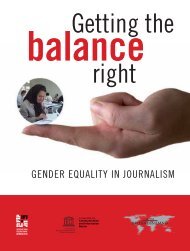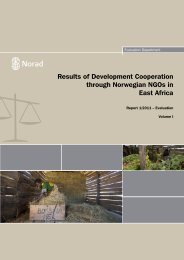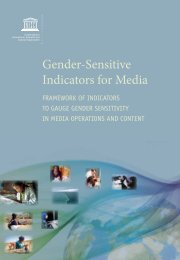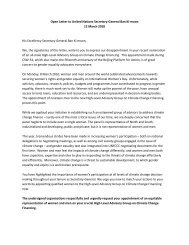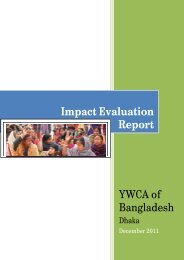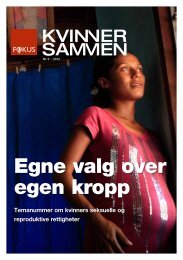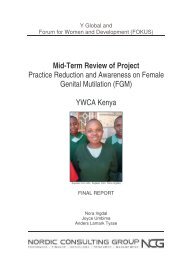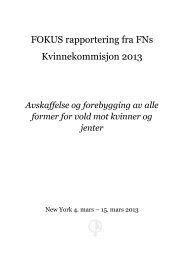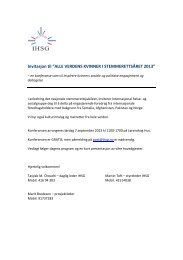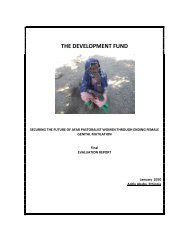TRAINING AND INFORMATION CAMPAIGN ON THE ... - Fokus
TRAINING AND INFORMATION CAMPAIGN ON THE ... - Fokus
TRAINING AND INFORMATION CAMPAIGN ON THE ... - Fokus
Create successful ePaper yourself
Turn your PDF publications into a flip-book with our unique Google optimized e-Paper software.
effective public speakers with fluency in several local languages. The TV-project has been especilly<br />
instrumental in freeing up Dr. Touray to work full-time on coordinating the project.<br />
GAMCOTRAP does not employ an approach of stressing charismatic personalities. Although both<br />
Amie and Isatou are indeed well known and respected in the communities in which they work (and their<br />
names at times show up in praise-songs) they stress that ”GAMCOTRAP is not Amie or Isatou.” The<br />
groundwork that they have done over so many years could be continued by other dedicated activists,<br />
and there is evidence of training of junior staff and volunteers and the transfer of competency, as was<br />
particularly demonstrated by the active participation in the dissemination exercise of Musa Jallow and<br />
Omar Dibbah. This philosophy was also evident during the field visit (as was also the case during the<br />
evaluator’s travels with the group in 1997-98) – GAMCOTRAP staff behave in an extremely humble<br />
way when ”on trek.” They use very modest accomodations, eat simple food, and work long hours without<br />
ever complaining about discomfort or fatigue. GAMCOTRAP staff meet community members on their<br />
own terms, joining them in their work and domestic responsibilities. They are acutely aware of farming<br />
cycles and women’s domestic labor burdens and make a genuine and concerted effort to empathize with<br />
the realities of the people they are trying to reach. GAMCOTRAP also has a firm policy of not handing<br />
out cash to praise-singers, kanyelengs, and others. Instead, they budget for a collective contribution to be<br />
given at the end of the visit to a designated group of women.<br />
GAMCOTRAP are veterans in the field of anti-FGM activism and are anchored in long-term<br />
relationships with the communities they serve, and their approach is characterized by frankness and<br />
transparency. While remaining attuned to the need to show respect (especially for elders, dignitaries, and<br />
individuals with particular prestige) the activists never conceal their agenda nor make excuses for their<br />
convictions. Because there has been no attempt throughout the sustained campaign to veil the message<br />
or hide it within other agendas, GAMCOTRAP appears to have ultimately gained the respect of the<br />
populations they have worked so long to sensitize.<br />
While never straying from the agenda that was set out at the inception of the Gambian IAC chapter,<br />
it is evident that GAMCOTRAP staff display flexibility and adaptability in tailoring their message to<br />
specific community realities and are open to making adjustements in campaign approaches over time.<br />
Thus, there has in some communities been a greater emphasis than in others on refuting the allegation<br />
that FGM is a religious injunction and breaking the taboo of men as sole custodians of religion; and<br />
GAMCOTRAP shows great skill in utilizing collaborations with religious scholars. They also display a<br />
great deal of insight into geographic and ethnic variations in the practice of FGM; and presentations<br />
are angled to best resonate with community realities. During the field visit, this was particularly evident<br />
in the advice offered regarding reproductive health care surrounding consummation of marriage in<br />
communities practicing ”sealing,” (an important component of the strengthening of IEC capacity of<br />
the traditional healers who are usually the first to treat these cases), as well as in discussions about Spain’s<br />
anti-FGM law in villages that have seen many of its young people emigrate there.<br />
When asked what changes have emerged in their campaign strategies over time, they pointed to<br />
the increasing use over the last few years of traditional communicators and drawing on the cultural<br />
centrality of dance, song, and music. Also, in the past, there was more of a strategy of training a few<br />
representatives from each of many communities, while they have now realized that this places too much<br />
of a burden on a few people to return to their communities and try to recount all that they learned<br />
in training and alone attempt to effect collective change (this was also expressed in some of the field<br />
interviews as extremely challenging by attendees who pleaded for the support of workshops to be held<br />
in their communities). Now they focus instead on mass meetings and collective change through targeting<br />
a ”cluster” of villages centered around a major community (see Appendix 5 for adiagram) aimed at<br />
18




